Is anyone running the SOLGW .223 Wylde, 1:8, 416R 18" barrel? I just picked one up and am wondering where a good place to start is with factory ammo. I'm going to be taking a class with it that shoots out to 800 yards. I'll be picking up a bunch of different loads and seeing which group best. Thanks
- Thread starter mangomedic
- Start date
You are using an out of date browser. It may not display this or other websites correctly.
You should upgrade or use an alternative browser.
You should upgrade or use an alternative browser.
What is the class? .223 @ 800 is doable but you likely will not get as much from the class.
Buck Doyle’s tremor 3 class. It’s out to 800 but most work is 400 and in. .308, 6.5 creedmoor, etc not allowed.What is the class? .223 @ 800 is doable but you likely will not get as much from the class.
I have run 69 smks out of a bolt to 600 and that was about max for the conditions.
The 75-77s are about your only option for 800yds with a semi. Hopefully it is just a couple shots here and there.
The 75-77s are about your only option for 800yds with a semi. Hopefully it is just a couple shots here and there.
. . . am wondering where a good place to start is with factory ammo.
The same place you would start for any other 5.56mm/223 semi-automatic AR-15 if you don't hand-load; a match-grade bullet loaded by a top-tier ammunition company.
Federal 69 grain Gold Medal Match Ammunition Accuracy
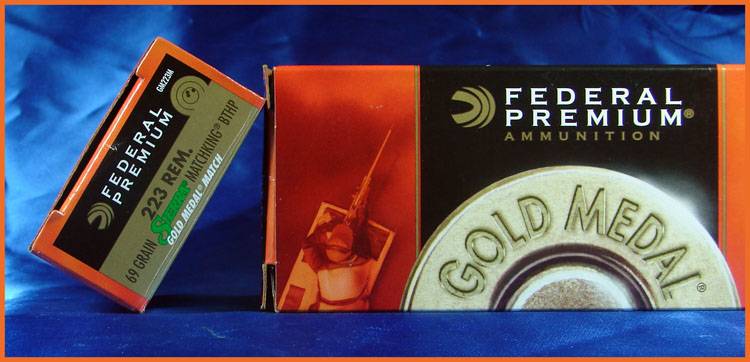
In their 1984 catalog, Sierra Bullets introduced the .22 caliber (0.224”) 69 grain MatchKing HPBT (hollow point boat tail) bullet (#1380). The 69 grain MatchKing was “developed as a target bullet for testing by military teams in the new M16A2 rifle”* and the bullet became a popular choice for shooters using the AR-15 in High Power Rifle Competition.
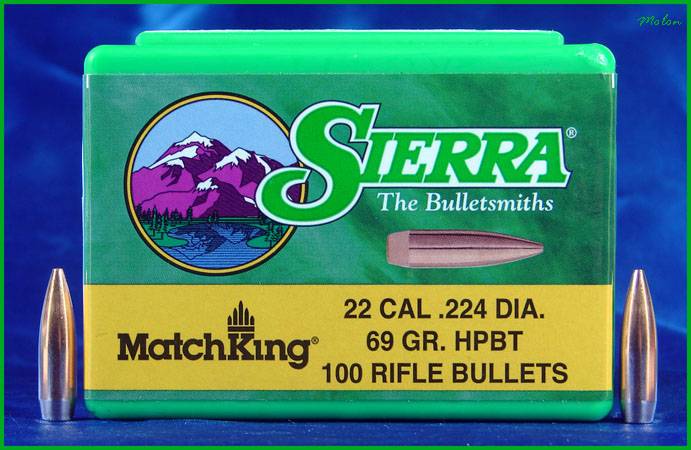
While the US military had experimented with “heavy” FMJ (full metal jacket) bullets for the 5.56mm cartridge as far back as the mid-1960s, (the Colt/Federal 5.56mm 68 grain FMJ) the .22 caliber 69 grain MatchKing was the first heavy OTM (open-tip match) bullet that was available to the general public as a reloading component for 223 Remington/5.56mm cartridges. (Hornady’s 68 grain OTM bullet (#2278) wasn’t introduced until approximately two years later.)

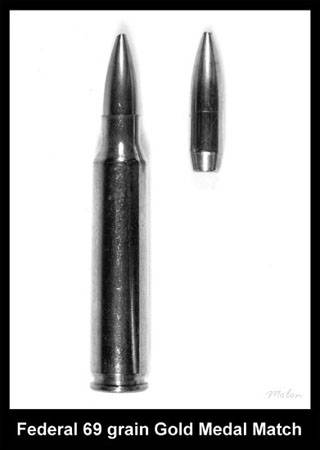
In their 1989 ammunition catalog, the Federal Cartridge Company debuted an addition to its “Match” line-up of factory loaded rifle ammunition; a 223 Remington load topped with none other than the Sierra 69 grain MatchKing (223M). In their 1992 catalog, Federal expanded the nomenclature for this load to “Premium Match” (P223M) and in their 1993 catalog it became “Gold Medal Match” (GM223M) as part of a marketing campaign capitalizing on the USA Shooting Team’s success in the Barcelona Olympics using Federal ammunition.
It’s interesting to note that pertaining to the accuracy/precision development and multifaceted testing of the Federal ammunition that helped the US Olympians win gold and silver medals in Barcelona, Federal’s Director of Product Engineering, Dave Longren, had this to say:
“The standard test string was three 10-shot groups, with the most attention paid to the 30-shot composite. When you’re working at this level, the traditional five 5-shot group test simply doesn’t give you statistically valid results.”**
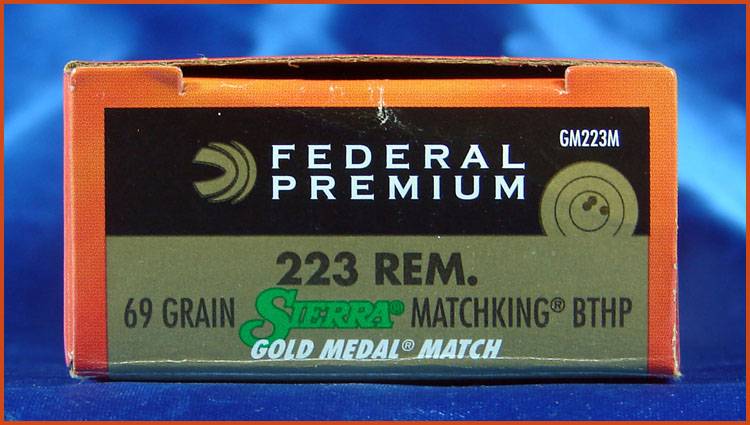

The 69 grain Sierra MatchKings loaded in the lot of Federal Gold Medal Match ammunition that I evaluated for this article had a nominal length of 0.890”. The nominal cartridge OAL of this load was 2.248”. Through some simple testing, I determined that the 69 grain MatchKing has a specific gravity of approximately 10.2.
According to Ballistic Performance of Rifle Bullets by Bryan Litz, the 69 grain MatchKing has an average G1 ballistic coefficient of 0.330 and an average G7 ballistic coefficient of 0.169. The same source states that the “recommended twist for optimal performance” of the 69 grain MatchKing “is 1:9.5” or faster.”
The 69 grain MatchKings that top the Federal Gold Medal Match ammunition are loaded in Federal brass. The head stamp for this lot reads “FC 13 223 REM”. The rounds are primed with Federal Gold Medal Small Rifle Match Primers (GM205M). The primer pockets are crimped and sealed with a blue lacquer sealant.
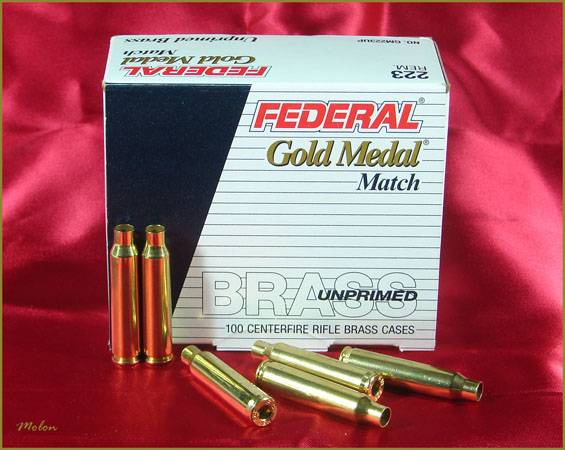
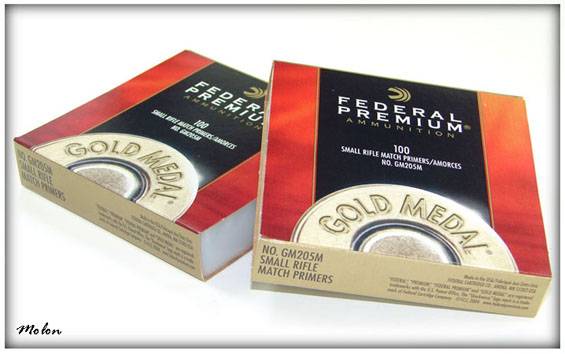

The case-mouths of this lot of Federal 69 grain Gold Medal Match ammunition are sealed with asphalt sealant. The case-mouths have a slight taper-crimp which produces a shallow circumferential crease in the bearing surface of the 69 grain MatchKings. The pic below shows a pulled bullet on the right (the crease in the bullet indicated by the red arrow) next to a virgin 69 grain MatchKing on the left.

This lot of ammunition is charged with a “ball powder” (though I have seen lots in the past that were charged with a short-cut extruded powder.) The squares in the red grid pictured below are 1/10th of an inch.
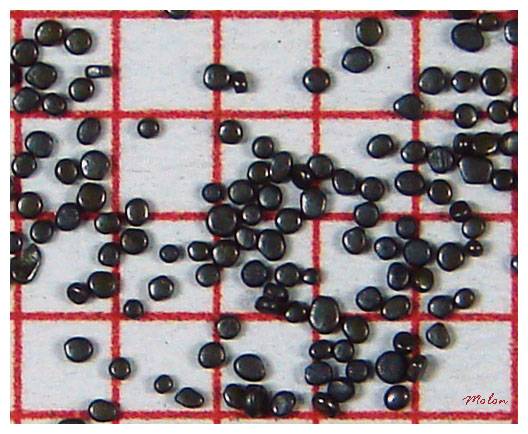
Velocity
When it was first introduced, Federal advertised the muzzle velocity of the 69 grain Gold Medal Match ammunition as 3000 FPS. More recent advertising lists the muzzle velocity at 2950 FPS. These figures are from 24” barrels.


I chronographed the Federal 69 grain Gold Medal Match ammunition from a semi-automatic AR-15 with a chrome-lined, NATO chambered 20” Colt M16A2 barrel with a 1:7” twist.

Chronographing was conducted using an Oehler 35-P chronograph with “proof screen” technology. The Oehler 35P chronograph is actually two chronographs in one package that takes two separate chronograph readings for each shot and then utilizes its onboard computer to analyze the data to determine if there is any statistically significant difference between the two readings. If there is a statistically significant difference in the readings, the chronograph “flags” the shot to let you know that the data is invalid. There was no invalid data flagged during this testing.
The velocities stated below are the muzzle velocities as calculated from the instrumental velocities using Oehler’s Ballistic Explorer software program. The strings of fire consisted of 10 rounds over the chronograph.
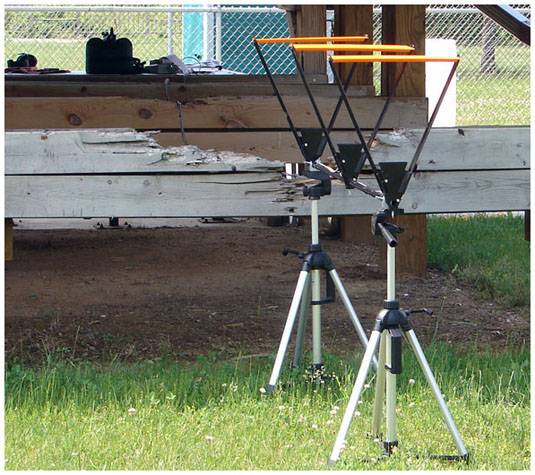
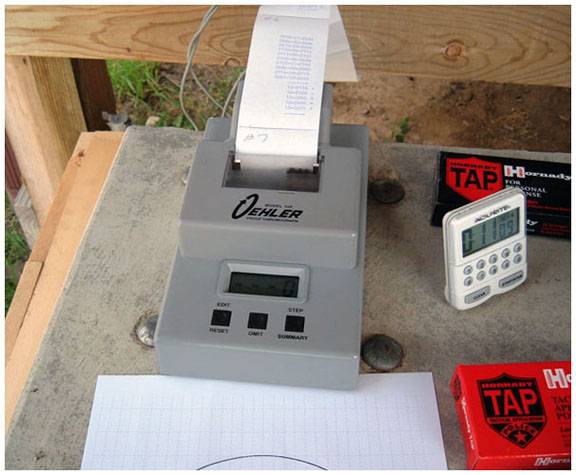
Each round was single-loaded and cycled into the chamber from a magazine fitted with a single-load follower. The bolt locked-back after each shot allowing the chamber to cool in between each shot. This technique was used to mitigate the possible influence of “chamber-soak” on velocity data. Each new shot was fired in a consistent manner after hitting the bolt release. Atmospheric conditions were monitored and recorded using a Kestrel 4000 Pocket Weather Tracker.
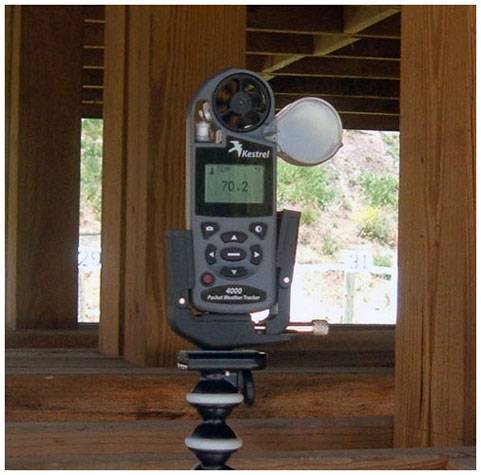
Atmospheric conditions
Temperature: 70 degrees F
Humidity: 76%
Barometric pressure: 30.14 inches of Hg
Elevation: 950 feet above sea level
The muzzle velocity for the 10-shot string of the Federal 69 grain Gold Medal Match ammunition fired from the 20” Colt barrel was 2732 FPS with a standard deviation of 16 FPS and a coefficient of variation of 0.59%.
For those of you who might not be familiar with the coefficient of variation (CV), it is the standard deviation, divided by the mean (average) muzzle velocity and then multiplied by 100 and expressed as a percentage. It allows for the comparison of the uniformity of velocity between loads in different velocity spectrums; e.g. 77 grain loads running around 2,650 fps compared to 55 grain loads running around 3,250 fps.
For comparison, the mil-spec for M193 allows for a coefficient of variation of approximately 1.2%, while one of my best 77 grain OTM hand-loads, with a muzzle velocity of 2639 PFS and a standard deviation of 4 FPS, has a coefficient of variation of 0.15%.

Over the last decade I’ve chronographed several other lots of the Federal 69 grain Gold Medal Match ammunition from a variety of barrels. The muzzle velocities of those lots are shown in the table below.

Accuracy
I conducted an accuracy (technically, precision) evaluation of the Federal 69 grain Gold Medal Match ammunition following my usual protocol. This accuracy evaluation used statistically significant shot-group sizes and every single shot in a fired group was included in the measurements. There was absolutely no use of any group-reduction techniques (e.g. fliers, target movement, Butterfly Shots).
The shooting set-up will be described in detail below. As many of the significant variables as was practicable were controlled for. Also, a control group was fired from the test-rifle used in the evaluation using match-grade, hand-loaded ammunition; in order to demonstrate the capability of the barrel. Pictures of shot-groups are posted for documentation.
All shooting was conducted from a concrete bench-rest from a distance of 100 yards (confirmed with a laser rangefinder.) The barrel used in the evaluation was free-floated. The free-float handguards of the rifle rested in a Sinclair Windage Benchrest, while the stock of the rifle rested in a Protektor bunny-ear rear bag. Sighting was accomplished via a Leupold Competition Series 45x45mm scope adjusted to be parallax-free at 100 yards. A mirage shield was attached to the top of the free-float handguard. Wind conditions on the shooting range were continuously monitored using a Wind Probe. The set-up was very similar to that pictured below.
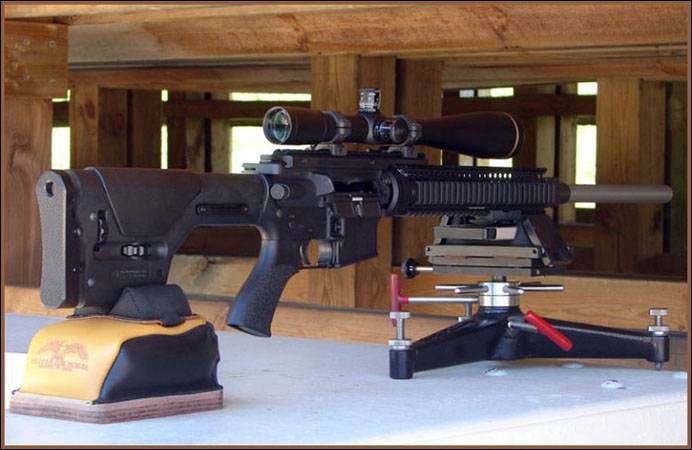
The Wind Probe.

The test vehicle for this accuracy evaluation was one of my semi-automatic precision AR-15s with a 24” Krieger barrel. The barrel has a 5.56mm Match chamber with a 1:7.7” twist. Prior to firing the 69 grain Gold Medal Match ammunition, I fired a 10-shot control group using match-grade hand-loads topped with the Barnes 85 grain Match Burner. That group had an extreme spread of 0.56”.
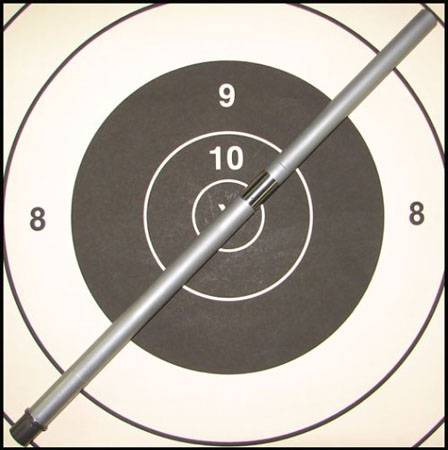
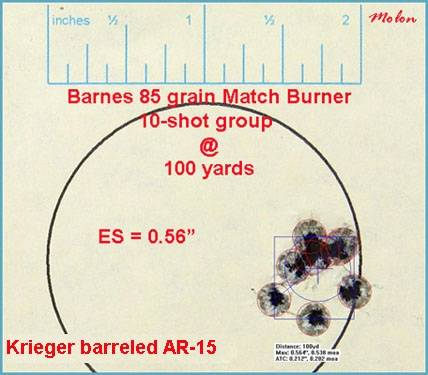
Three 10-shot groups of the 69 grain Gold Medal Match ammunition were fired in a row with the resulting extreme spreads:
0.67”
0.73”
0.67”
for a 10-shot group average extreme spread of 0.69”. The three 10-shot groups were over-layed on each other using RSI Shooting Lab to form a 30-shot composite group. The mean radius for the 30-shot composite group was 0.24”.
The smallest 10-shot group . . .
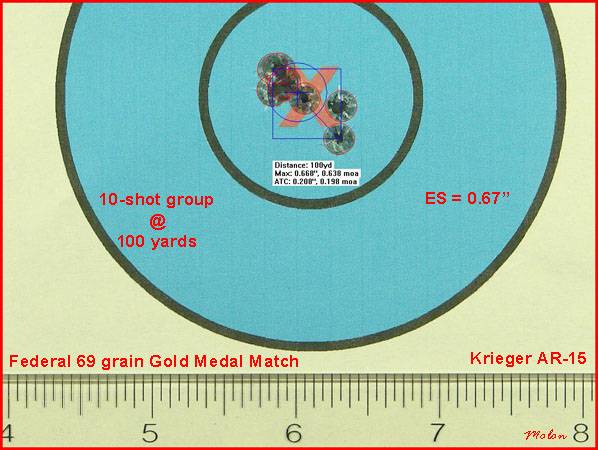
The 30-shot composite group . . .

....
* Technical Staff. “Sierra .22 Cal. 69-gr. MatchKing.” American Rifleman Jan. 1984: 60-61. Print.
** Hunnicutt, Robert. “Ammo Good as Gold.” American Rifleman Nov. 1992: 32-33, 72-73. Print.
....
continued . . .
Black Hills 5.56mm 77 Grain Tipped MatchKing Ammunition

The Black Hills 5.56mm 77 grain Tipped MatchKing ammunition is loaded with the same Sierra 77 grain Tipped MatchKing projectile that is available as a reloading component (#7177), with the addition of a cannelure. The Black Hills ammunition was actually brought to market before the reloading component was.
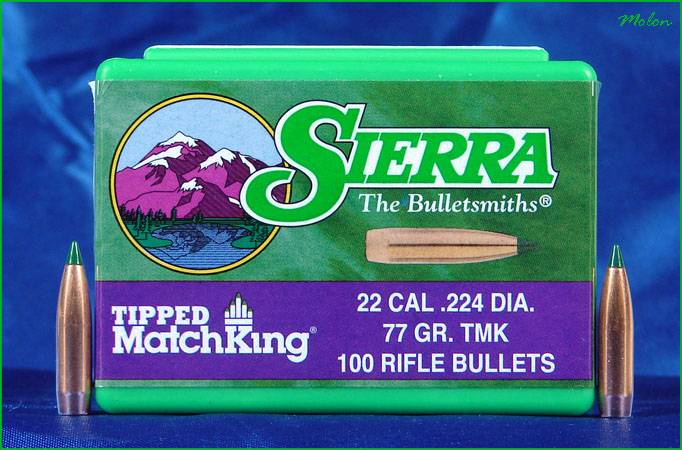
The 77 grain Tipped MatchKing is the longest bullet (that I’m aware of) that is currently being loaded by a major manufacturer to magazine length for the 5.56mm cartridge.
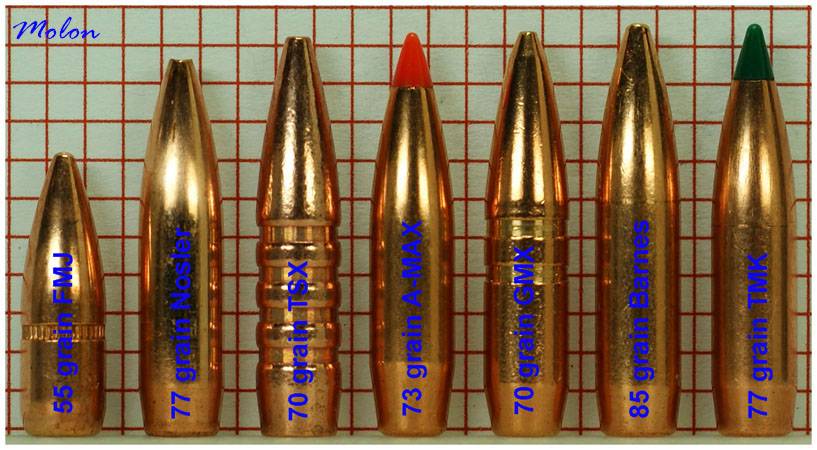
With a nominal length of 1.070”, the 77 grain Tipped MatchKing is 0.335” longer than a 55 grain FMJ bullet and 0.085” longer than the standard Sierra 77 grain MatchKing.

Not only is the bullet itself long, but the ogive section of the 77 grain Tipped MatchKing is also extremely long for a bullet loaded to magazine length in the 5.56mm cartridge; so much so, that the grooves of the cannelure extend into the ogive of the bullet, as evidenced by the “arrow head” shaped cannelure grooves.
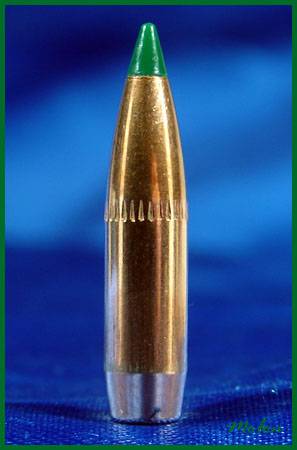

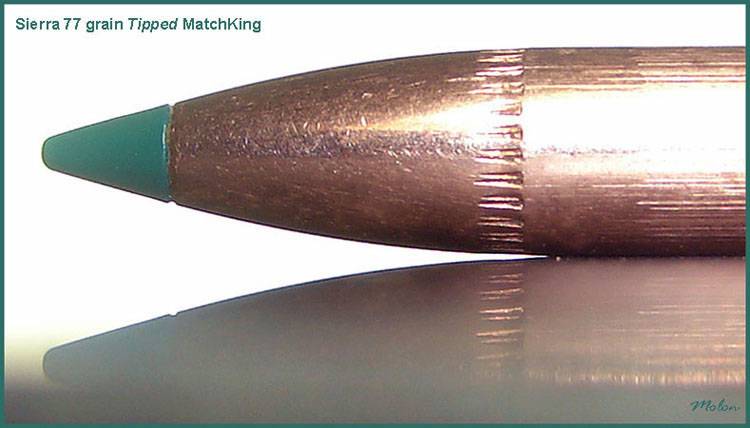
The Black Hills 77 grain Tipped MatchKing ammunition is loaded in 5.56mm WCC brass that has the annealing iris still visible. The primer pockets are crimped and sealed. The case-mouth is crimped but has no sealant. The load is charged with “ball powder.”

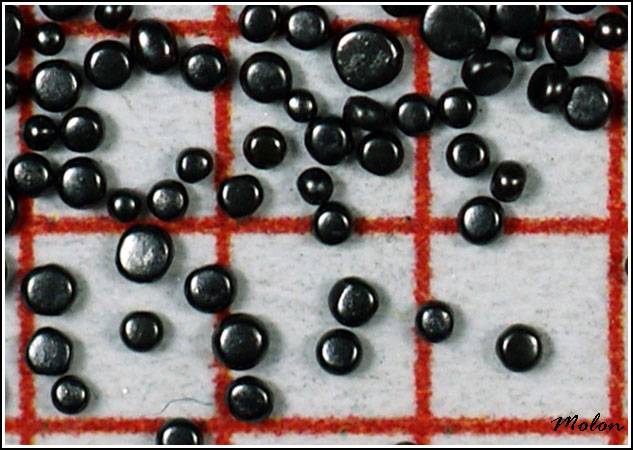
Velocity[/size=6]
I chronographed the Black Hills 77 grain Tipped MatchKing ammunition from a semi-automatic AR-15 with a chrome-lined, NATO chambered 20” Colt M16A2 barrel with a 1:7” twist.

Chronographing was conducted using an Oehler 35-P chronograph with “proof screen” technology. The Oehler 35P chronograph is actually two chronographs in one package that takes two separate chronograph readings for each shot and then utilizes its onboard computer to analyze the data to determine if there is any statistically significant difference between the two readings. If there is a statistically significant difference in the readings, the chronograph “flags” the shot to let you know that the data is invalid. There was no invalid data flagged during this testing.
The velocities stated below are the muzzle velocities as calculated from the instrumental velocities using Oehler’s Ballistic Explorer software program. The strings of fire consisted of 10 rounds over the chronograph.
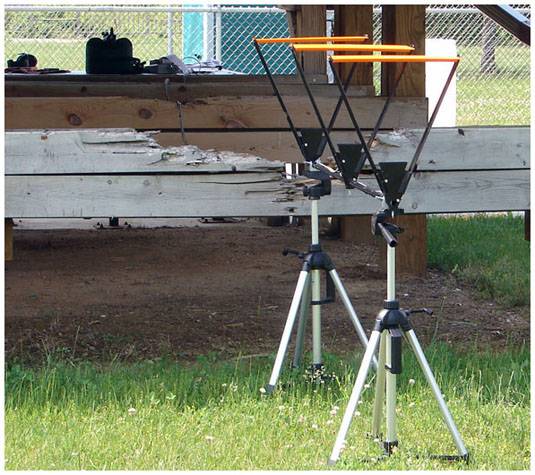
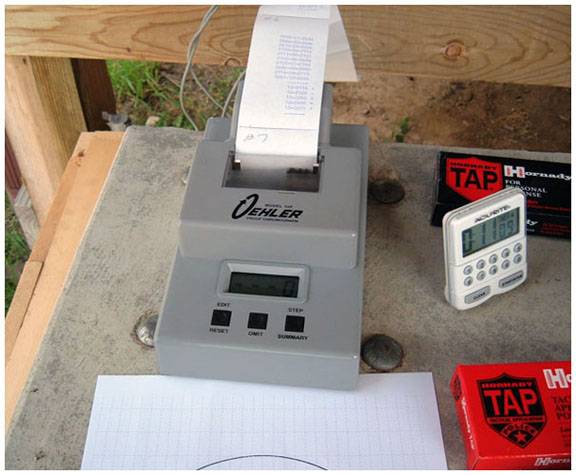
Each round was single-loaded and cycled into the chamber from a magazine fitted with a single-load follower. The bolt locked-back after each shot allowing the chamber to cool in between each shot. This technique was used to mitigate the possible influence of “chamber-soak” on velocity data. Each new shot was fired in a consistent manner after hitting the bolt release. Atmospheric conditions were monitored and recorded using a Kestrel 4000 Pocket Weather Tracker.

Atmospheric conditions
Temperature: 72 degrees F
Humidity: 44%
Barometric pressure: 29.64 inches of Hg
Elevation: 950 feet above sea level
The muzzle velocity for the 10-shot string of the Black Hills 77 grain Tipped MatchKing ammunition fired from the 20” Colt barrel was 2808 FPS with a standard deviation of 14 FPS and a coefficient of variation of 0.50%.
For those of you who might not be familiar with the coefficient of variation (CV), it is the standard deviation, divided by the mean (average) muzzle velocity and then multiplied by 100 and expressed as a percentage. It allows for the comparison of the uniformity of velocity between loads in different velocity spectrums; e.g. 77 grain loads running around 2,650 fps compared to 55 grain loads running around 3,250 fps.
For comparison, the mil-spec for M193 allows for a coefficient of variation of approximately 1.2%, while one of my best 77 grain OTM hand-loads, with a muzzle velocity of 2639 PFS and a standard deviation of 4 FPS, has a coefficient of variation of 0.15%.

Accuracy[/size=6]
I conducted an accuracy (technically, precision) evaluation of the Black Hills 77 grain Tipped MatchKing ammunition following my usual protocol. This accuracy evaluation used statistically significant shot-group sizes and every single shot in a fired group was included in the measurements. There was absolutely no use of any group-reduction techniques (e.g. fliers, target movement, Butterfly Shots).
The shooting set-up will be described in detail below. As many of the significant variables as was practicable were controlled for. Also, a control group was fired from the test-rifle used in the evaluation using match-grade, hand-loaded ammunition; in order to demonstrate the capability of the barrel. Pictures of shot-groups are posted for documentation.
All shooting was conducted from a concrete bench-rest from a distance of 100 yards (confirmed with a laser rangefinder.) The barrel used in the evaluation was free-floated. The free-float handguards of the rifle rested in a Sinclair Windage Benchrest, while the stock of the rifle rested in a Protektor bunny-ear rear bag. Sighting was accomplished via a Leupold VARI-X III set at 25x magnification and adjusted to be parallax-free at 100 yards. A mirage shade was attached to the top of the free-float hand-guard. Wind conditions on the shooting range were continuously monitored using a Wind Probe. The set-up was very similar to that pictured below.

The Wind Probe.

The test vehicle for this accuracy evaluation was one of my semi-automatic precision AR-15s with a 20” stainless-steel Lothar-Walther barrel. The barrel has a 223 Wylde chamber with a 1.8” twist. Prior to firing the Black Hills 77 grain Tipped MatchKing, I fired a 10-shot control group using match-grade hand-loads topped with the Sierra 77 grain Tipped MatchKing (without a canelure). That group had an extreme spread of 0.68”.
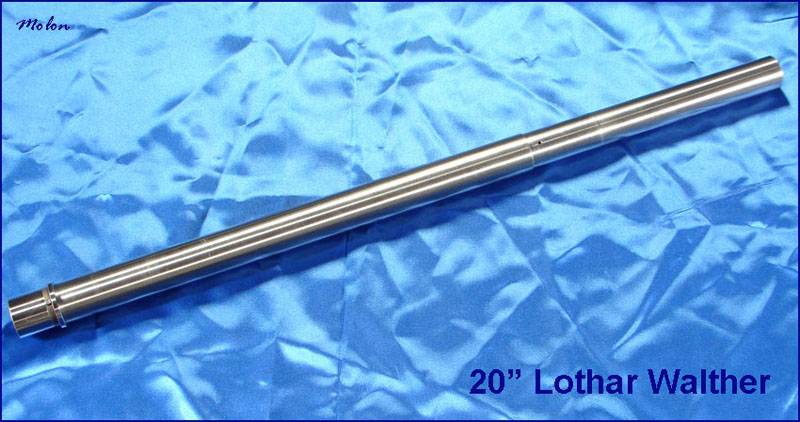
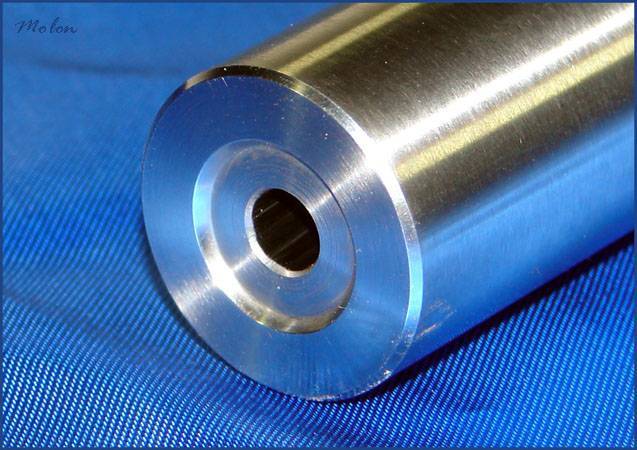
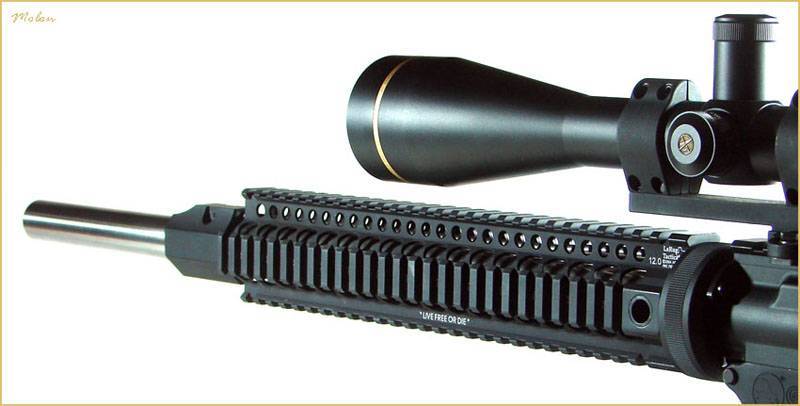
the control group . . .

Three 10-shot groups of the Black Hills 77 grain Tipped MatchKings ammunition were fired in a row with the resulting extreme spreads:
1.26”
1.14”
1.37”
for a 10-shot group average extreme spread of 1.26”. The three 10-shot groups were over-layed on each other using RSI Shooting Lab to form a 30-shot composite group. The mean radius for the 30-shot composite group was 0.41”.
The smallest 10-shot group . . .
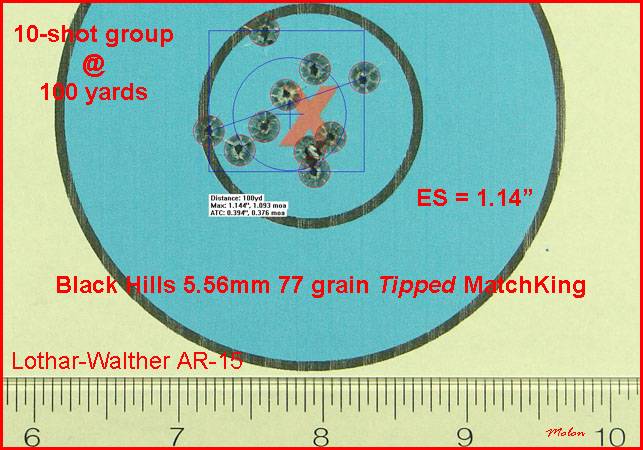
The 30-shot composite group . . .
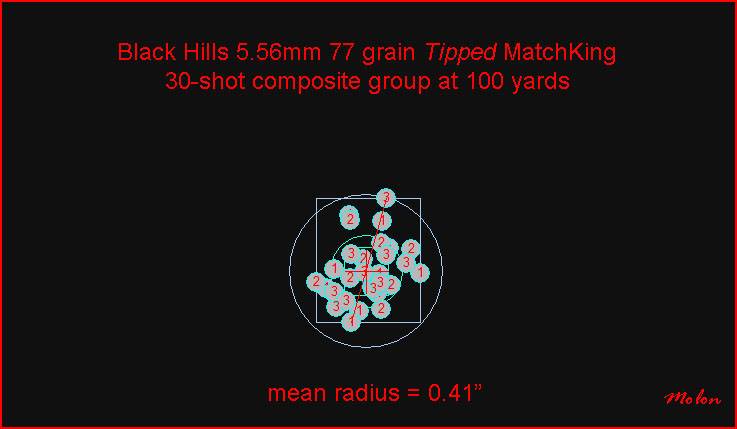
MK262 Comparison[/size=5]
The table below compares the test results from this article to my previously obtained test data for Black Hills MK262 Mod 1 ammunition, which is loaded with the standard Sierra 77 grain MatchKing (with a cannelure.)
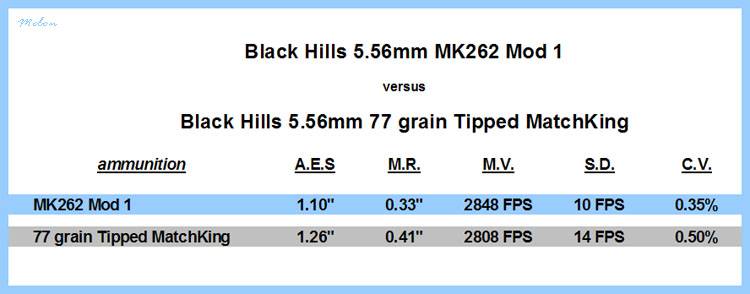
A.E.S = average extreme spread for three 10-shot groups at 100 yards
M.R. = mean radius for the 30-shot composite group
M.V. = muzzle velocity
S.D. = standard deviation of muzzle velocity
C.V. = coefficient of variation of muzzle velocity
…
continued . . .

The Black Hills 5.56mm 77 grain Tipped MatchKing ammunition is loaded with the same Sierra 77 grain Tipped MatchKing projectile that is available as a reloading component (#7177), with the addition of a cannelure. The Black Hills ammunition was actually brought to market before the reloading component was.

The 77 grain Tipped MatchKing is the longest bullet (that I’m aware of) that is currently being loaded by a major manufacturer to magazine length for the 5.56mm cartridge.

With a nominal length of 1.070”, the 77 grain Tipped MatchKing is 0.335” longer than a 55 grain FMJ bullet and 0.085” longer than the standard Sierra 77 grain MatchKing.

Not only is the bullet itself long, but the ogive section of the 77 grain Tipped MatchKing is also extremely long for a bullet loaded to magazine length in the 5.56mm cartridge; so much so, that the grooves of the cannelure extend into the ogive of the bullet, as evidenced by the “arrow head” shaped cannelure grooves.



The Black Hills 77 grain Tipped MatchKing ammunition is loaded in 5.56mm WCC brass that has the annealing iris still visible. The primer pockets are crimped and sealed. The case-mouth is crimped but has no sealant. The load is charged with “ball powder.”


Velocity[/size=6]
I chronographed the Black Hills 77 grain Tipped MatchKing ammunition from a semi-automatic AR-15 with a chrome-lined, NATO chambered 20” Colt M16A2 barrel with a 1:7” twist.

Chronographing was conducted using an Oehler 35-P chronograph with “proof screen” technology. The Oehler 35P chronograph is actually two chronographs in one package that takes two separate chronograph readings for each shot and then utilizes its onboard computer to analyze the data to determine if there is any statistically significant difference between the two readings. If there is a statistically significant difference in the readings, the chronograph “flags” the shot to let you know that the data is invalid. There was no invalid data flagged during this testing.
The velocities stated below are the muzzle velocities as calculated from the instrumental velocities using Oehler’s Ballistic Explorer software program. The strings of fire consisted of 10 rounds over the chronograph.


Each round was single-loaded and cycled into the chamber from a magazine fitted with a single-load follower. The bolt locked-back after each shot allowing the chamber to cool in between each shot. This technique was used to mitigate the possible influence of “chamber-soak” on velocity data. Each new shot was fired in a consistent manner after hitting the bolt release. Atmospheric conditions were monitored and recorded using a Kestrel 4000 Pocket Weather Tracker.

Atmospheric conditions
Temperature: 72 degrees F
Humidity: 44%
Barometric pressure: 29.64 inches of Hg
Elevation: 950 feet above sea level
The muzzle velocity for the 10-shot string of the Black Hills 77 grain Tipped MatchKing ammunition fired from the 20” Colt barrel was 2808 FPS with a standard deviation of 14 FPS and a coefficient of variation of 0.50%.
For those of you who might not be familiar with the coefficient of variation (CV), it is the standard deviation, divided by the mean (average) muzzle velocity and then multiplied by 100 and expressed as a percentage. It allows for the comparison of the uniformity of velocity between loads in different velocity spectrums; e.g. 77 grain loads running around 2,650 fps compared to 55 grain loads running around 3,250 fps.
For comparison, the mil-spec for M193 allows for a coefficient of variation of approximately 1.2%, while one of my best 77 grain OTM hand-loads, with a muzzle velocity of 2639 PFS and a standard deviation of 4 FPS, has a coefficient of variation of 0.15%.

Accuracy[/size=6]
I conducted an accuracy (technically, precision) evaluation of the Black Hills 77 grain Tipped MatchKing ammunition following my usual protocol. This accuracy evaluation used statistically significant shot-group sizes and every single shot in a fired group was included in the measurements. There was absolutely no use of any group-reduction techniques (e.g. fliers, target movement, Butterfly Shots).
The shooting set-up will be described in detail below. As many of the significant variables as was practicable were controlled for. Also, a control group was fired from the test-rifle used in the evaluation using match-grade, hand-loaded ammunition; in order to demonstrate the capability of the barrel. Pictures of shot-groups are posted for documentation.
All shooting was conducted from a concrete bench-rest from a distance of 100 yards (confirmed with a laser rangefinder.) The barrel used in the evaluation was free-floated. The free-float handguards of the rifle rested in a Sinclair Windage Benchrest, while the stock of the rifle rested in a Protektor bunny-ear rear bag. Sighting was accomplished via a Leupold VARI-X III set at 25x magnification and adjusted to be parallax-free at 100 yards. A mirage shade was attached to the top of the free-float hand-guard. Wind conditions on the shooting range were continuously monitored using a Wind Probe. The set-up was very similar to that pictured below.

The Wind Probe.

The test vehicle for this accuracy evaluation was one of my semi-automatic precision AR-15s with a 20” stainless-steel Lothar-Walther barrel. The barrel has a 223 Wylde chamber with a 1.8” twist. Prior to firing the Black Hills 77 grain Tipped MatchKing, I fired a 10-shot control group using match-grade hand-loads topped with the Sierra 77 grain Tipped MatchKing (without a canelure). That group had an extreme spread of 0.68”.



the control group . . .

Three 10-shot groups of the Black Hills 77 grain Tipped MatchKings ammunition were fired in a row with the resulting extreme spreads:
1.26”
1.14”
1.37”
for a 10-shot group average extreme spread of 1.26”. The three 10-shot groups were over-layed on each other using RSI Shooting Lab to form a 30-shot composite group. The mean radius for the 30-shot composite group was 0.41”.
The smallest 10-shot group . . .

The 30-shot composite group . . .

MK262 Comparison[/size=5]
The table below compares the test results from this article to my previously obtained test data for Black Hills MK262 Mod 1 ammunition, which is loaded with the standard Sierra 77 grain MatchKing (with a cannelure.)

A.E.S = average extreme spread for three 10-shot groups at 100 yards
M.R. = mean radius for the 30-shot composite group
M.V. = muzzle velocity
S.D. = standard deviation of muzzle velocity
C.V. = coefficient of variation of muzzle velocity
…
continued . . .
Range Report: Black Hills MK262 Mod 1

The 77 grain MK262 ammunition produced by Black Hills Ammunition has been referred to as the most accurate mass-produced 5.56mm ammunition that has ever been type-classified and issued by the US military. Since its inception, genuine MK262 has been manufactured solely by Black Hills Ammunition. For years, MK262 was only available to the civilian population as “seconds,” but more recently Black Hills has made first-run production lots available on the commercial market. It is the first-run version of MK262 Mod 1 that I tested for this report.
MK262 Mod 1 is loaded in WCC 5.56mm brass and uses a cannelured version of the 77 grain Sierra MatchKing. The round is charged with a proprietary ball powder. The primer pockets are crimped and sealed. Contrary to erroneous information that has been posted on the Internet, MK262 Mod 1 does not have case-mouth sealant.

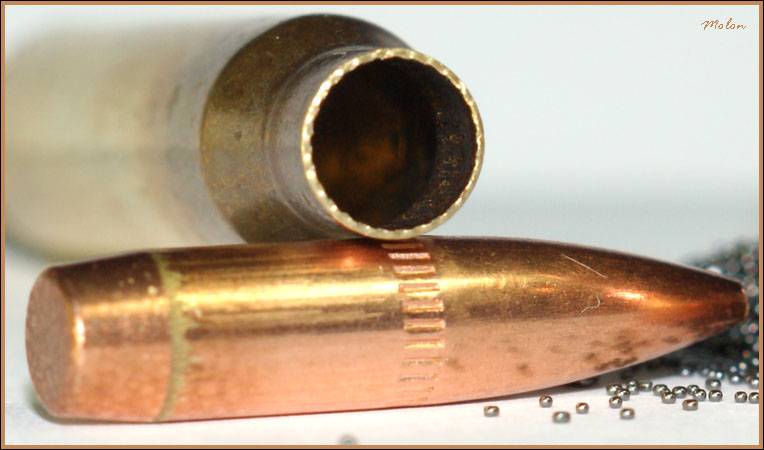
The 77 grain MK262 Mod 1 projectile compared to the M193 projectile.

MK262 powder. (The squares of the red grid measure 1/10 of an inch.)
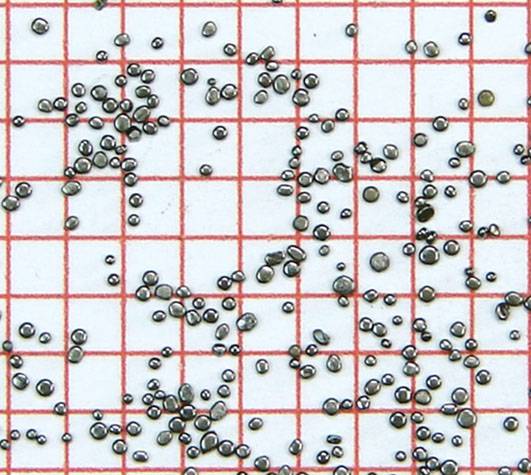
Accuracy[/size=6]
The specification for the accuracy/precision portion of the lot-acceptance-testing of MK262 calls for multiple 10-shot groups to be fired; which is exactly what I like to do for a range report. An accuracy (technically, precision) evaluation of the first-run MK262 Mod 1 ammunition was performed following my usual protocol. This accuracy evaluation used statistically significant shot-group sizes and every single shot in a fired group was included in the measurements. There was absolutely no use of any Group Reduction Techniques (e.g. fliers, target movement, Butterfly Shots).
The shooting set-up will be described in detail below. As many of the significant variables as was practicable were controlled for. Also, a control group was fired from the test-rifle used in the evaluation using match-grade, hand-loaded ammunition; in order to demonstrate the capability of the barrel. Pictures of shot-groups are posted for documentation.
All shooting was conducted from a concrete bench-rest from a distance of 100 yards (confirmed with a laser rangefinder.) The barrel used in the evaluation was free-floated. The free-float handguards of the rifle rested in a Sinclair Windage Benchrest, while the stock of the rifle rested in a Protektor bunny-ear rear bag. Sighting was accomplished via a Leupold VARI-X III set at 25X magnification and adjusted to be parallax-free at 100 yards. A mirage shade was used. Wind conditions on the shooting range were continuously monitored using a Wind Probe. The set-up was very similar to that pictured below.
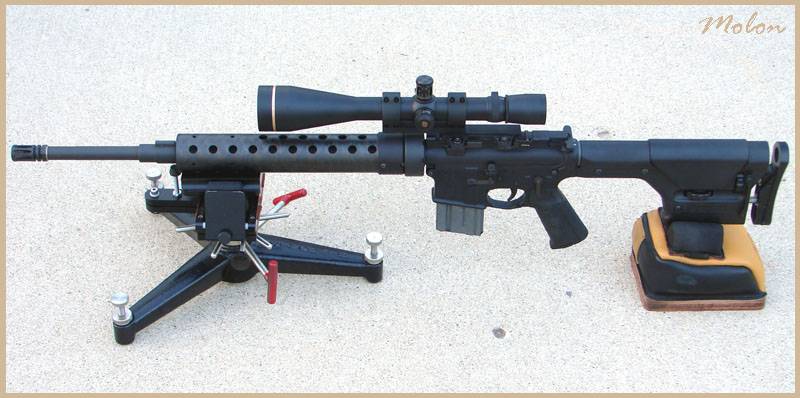
The Wind Probe.
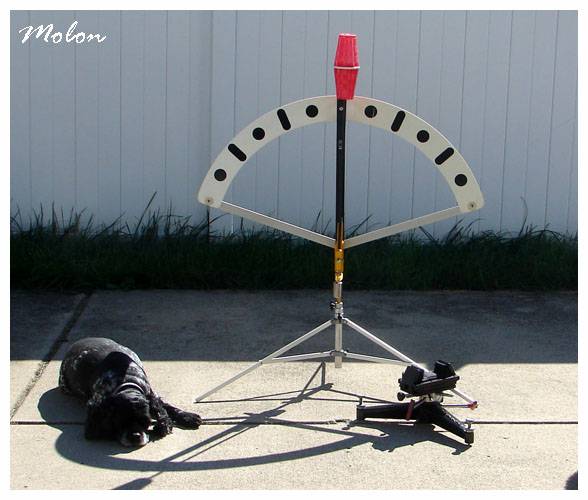
The test vehicle for this evaluation was one of my semi-automatic precision AR-15s with a 20” stainless-steel Lothar Walther barrel. The barrel has a 223 Wylde chamber with a 1:8” twist.
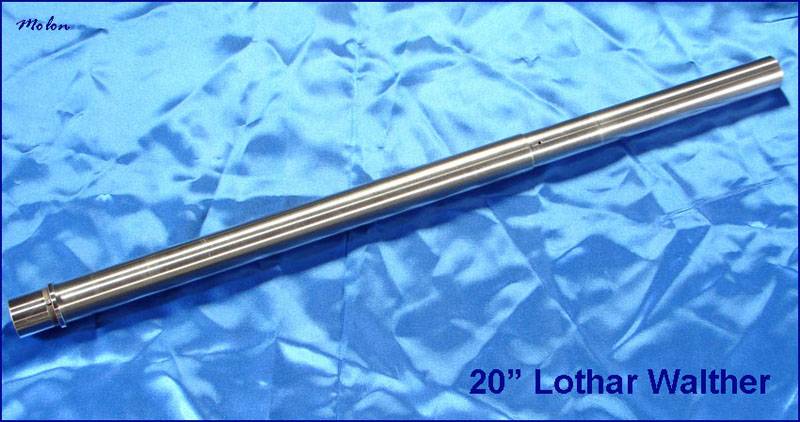
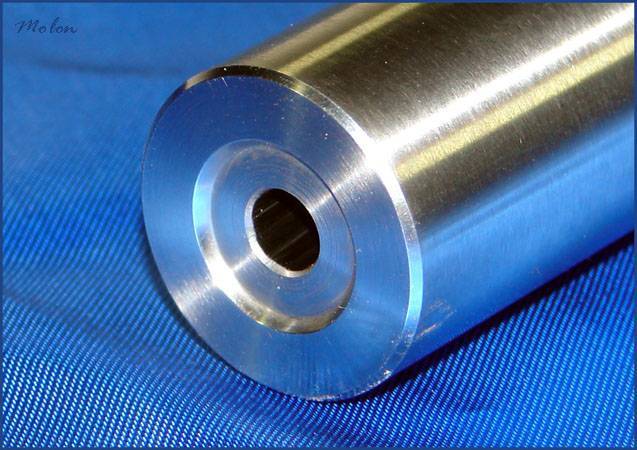
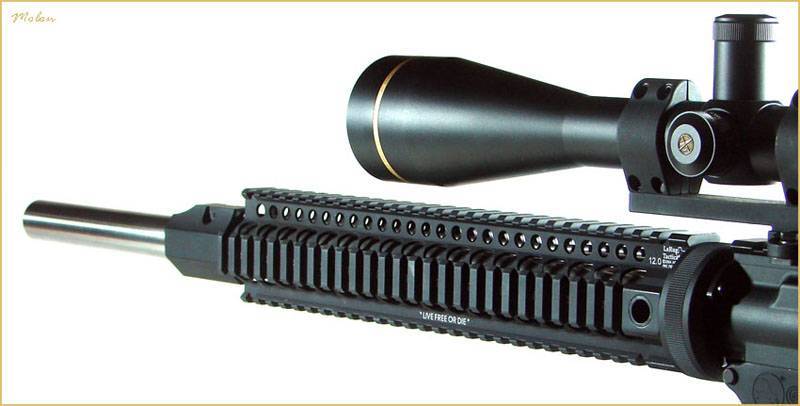
Prior to firing the MK262 ammunition, I fired a 10-shot control group using match-grade hand-loads topped with the Sierra 77 grain MatchKing. That group had an extreme spread of 0.69”.
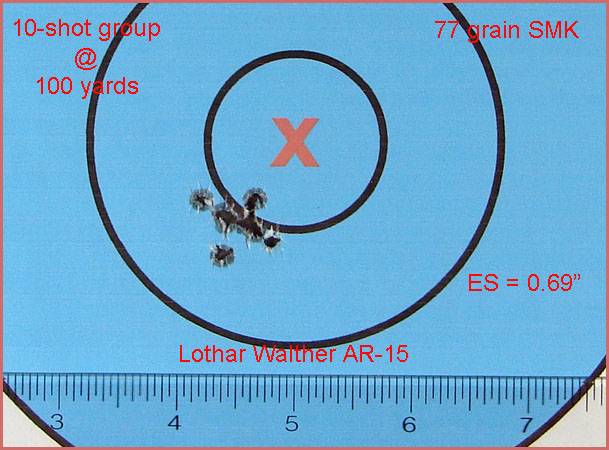
Three 10-shot groups of the MK262 Mod 1 were fired in a row with the resulting extreme spreads (from smallest to largest):
0.96”
1.12”
1.21”
for a 10-shot group average extreme spread of 1.10” (1.05 MOA). The three 10-shot groups were over-layed on each other using RSI Shooting Lab to form a 30-shot composite group. The mean radius for the 30-shot composite group was 0.33”.
The smallest 10-shot group.
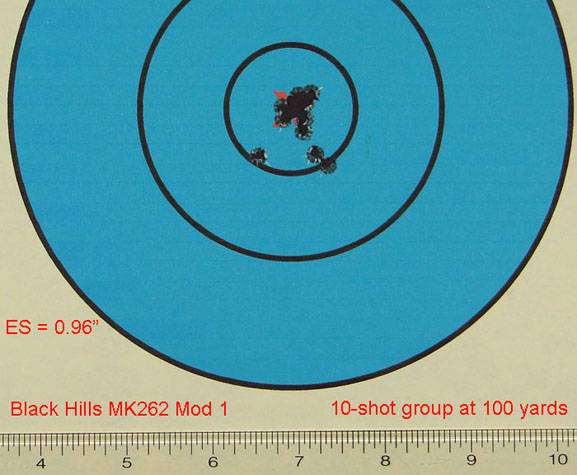
The 30-shot composite group.
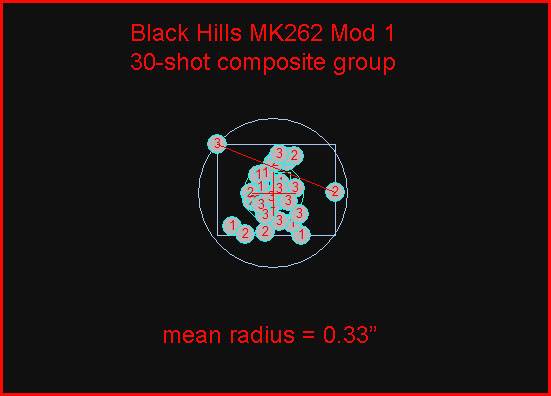
Velocity[/size=6]
I chronographed the Black Hills 5.56mm MK262 Mod 1 ammunition from a semi-automatic AR-15 with a chrome-lined, NATO chambered 20” Colt M16A2 barrel.

Chronographing was conducted using an Oehler 35-P chronograph with “proof screen” technology. The Oehler 35P chronograph is actually two chronographs in one package that takes two separate chronograph readings for each shot and then has its onboard computer analyze the data to determine if there is any statistically significant difference between the two readings. If there is, the chronograph “flags” the shot to let you know that the data is invalid. There was no invalid data flagged during this testing.
The velocity stated below is the muzzle velocity as calculated from the instrumental velocity using Oehler’s Ballistic Explorer software program. The string of fire consisted of 10 rounds over the chronograph.
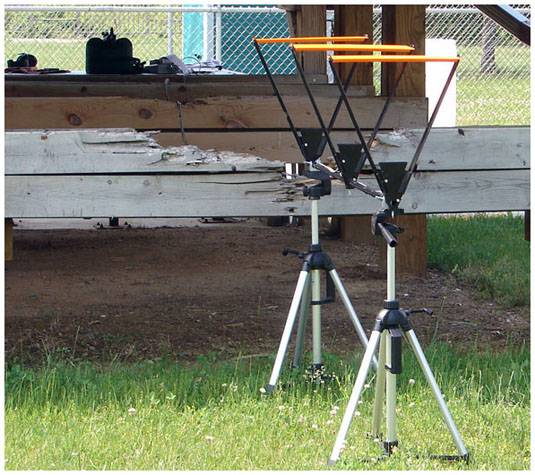

Each round was single-loaded and cycled into the chamber from a magazine fitted with a single-load follower. The bolt locked-back after each shot allowing the chamber to cool in between each shot. This technique was used to mitigate the possible influence of “chamber-soak” on velocity data. Each new shot was fired in a consistent manner after hitting the bolt release. Atmospheric conditions were monitored and recorded using a Kestrel 4000 Pocket Weather Tracker.

Atmospheric conditions
Temperature: 79 degrees F
Humidity: 37%
Barometric pressure: 30.12 inches of Hg
Elevation: 950 feet above sea level
The muzzle velocity for the 10-shot string of the Black Hills 5.56mm MK262 Mod 1 ammunition fired from the 20” Colt barrel was 2848 FPS with a standard deviation of 10 FPS and a coefficient of variation of 0.35%!
For those of you who might not be familiar with the coefficient of variation (CV), it is the standard deviation, divided by the mean (average) muzzle velocity and then multiplied by 100 and expressed as a percentage. It allows for the comparison of the uniformity of velocity between loads in different velocity spectrums; e.g. 77 grain loads running around 2,650 fps compared to 55 grain loads running around 3,250 fps.
For comparison (and to give you an idea of how good the CV is for this factory loaded MK262 Mod 1 ammunition) the mil-spec for M193 allows for a coefficient of variation of approximately 1.2%, while one of my best 77 grain OTM hand-loads, with a muzzle velocity of 2639 PFS and a standard deviation of 4 FPS, has a coefficient of variation of 0.15%.

….
continued . . .

The 77 grain MK262 ammunition produced by Black Hills Ammunition has been referred to as the most accurate mass-produced 5.56mm ammunition that has ever been type-classified and issued by the US military. Since its inception, genuine MK262 has been manufactured solely by Black Hills Ammunition. For years, MK262 was only available to the civilian population as “seconds,” but more recently Black Hills has made first-run production lots available on the commercial market. It is the first-run version of MK262 Mod 1 that I tested for this report.
MK262 Mod 1 is loaded in WCC 5.56mm brass and uses a cannelured version of the 77 grain Sierra MatchKing. The round is charged with a proprietary ball powder. The primer pockets are crimped and sealed. Contrary to erroneous information that has been posted on the Internet, MK262 Mod 1 does not have case-mouth sealant.


The 77 grain MK262 Mod 1 projectile compared to the M193 projectile.

MK262 powder. (The squares of the red grid measure 1/10 of an inch.)

Accuracy[/size=6]
The specification for the accuracy/precision portion of the lot-acceptance-testing of MK262 calls for multiple 10-shot groups to be fired; which is exactly what I like to do for a range report. An accuracy (technically, precision) evaluation of the first-run MK262 Mod 1 ammunition was performed following my usual protocol. This accuracy evaluation used statistically significant shot-group sizes and every single shot in a fired group was included in the measurements. There was absolutely no use of any Group Reduction Techniques (e.g. fliers, target movement, Butterfly Shots).
The shooting set-up will be described in detail below. As many of the significant variables as was practicable were controlled for. Also, a control group was fired from the test-rifle used in the evaluation using match-grade, hand-loaded ammunition; in order to demonstrate the capability of the barrel. Pictures of shot-groups are posted for documentation.
All shooting was conducted from a concrete bench-rest from a distance of 100 yards (confirmed with a laser rangefinder.) The barrel used in the evaluation was free-floated. The free-float handguards of the rifle rested in a Sinclair Windage Benchrest, while the stock of the rifle rested in a Protektor bunny-ear rear bag. Sighting was accomplished via a Leupold VARI-X III set at 25X magnification and adjusted to be parallax-free at 100 yards. A mirage shade was used. Wind conditions on the shooting range were continuously monitored using a Wind Probe. The set-up was very similar to that pictured below.

The Wind Probe.

The test vehicle for this evaluation was one of my semi-automatic precision AR-15s with a 20” stainless-steel Lothar Walther barrel. The barrel has a 223 Wylde chamber with a 1:8” twist.



Prior to firing the MK262 ammunition, I fired a 10-shot control group using match-grade hand-loads topped with the Sierra 77 grain MatchKing. That group had an extreme spread of 0.69”.

Three 10-shot groups of the MK262 Mod 1 were fired in a row with the resulting extreme spreads (from smallest to largest):
0.96”
1.12”
1.21”
for a 10-shot group average extreme spread of 1.10” (1.05 MOA). The three 10-shot groups were over-layed on each other using RSI Shooting Lab to form a 30-shot composite group. The mean radius for the 30-shot composite group was 0.33”.
The smallest 10-shot group.

The 30-shot composite group.

Velocity[/size=6]
I chronographed the Black Hills 5.56mm MK262 Mod 1 ammunition from a semi-automatic AR-15 with a chrome-lined, NATO chambered 20” Colt M16A2 barrel.

Chronographing was conducted using an Oehler 35-P chronograph with “proof screen” technology. The Oehler 35P chronograph is actually two chronographs in one package that takes two separate chronograph readings for each shot and then has its onboard computer analyze the data to determine if there is any statistically significant difference between the two readings. If there is, the chronograph “flags” the shot to let you know that the data is invalid. There was no invalid data flagged during this testing.
The velocity stated below is the muzzle velocity as calculated from the instrumental velocity using Oehler’s Ballistic Explorer software program. The string of fire consisted of 10 rounds over the chronograph.


Each round was single-loaded and cycled into the chamber from a magazine fitted with a single-load follower. The bolt locked-back after each shot allowing the chamber to cool in between each shot. This technique was used to mitigate the possible influence of “chamber-soak” on velocity data. Each new shot was fired in a consistent manner after hitting the bolt release. Atmospheric conditions were monitored and recorded using a Kestrel 4000 Pocket Weather Tracker.

Atmospheric conditions
Temperature: 79 degrees F
Humidity: 37%
Barometric pressure: 30.12 inches of Hg
Elevation: 950 feet above sea level
The muzzle velocity for the 10-shot string of the Black Hills 5.56mm MK262 Mod 1 ammunition fired from the 20” Colt barrel was 2848 FPS with a standard deviation of 10 FPS and a coefficient of variation of 0.35%!
For those of you who might not be familiar with the coefficient of variation (CV), it is the standard deviation, divided by the mean (average) muzzle velocity and then multiplied by 100 and expressed as a percentage. It allows for the comparison of the uniformity of velocity between loads in different velocity spectrums; e.g. 77 grain loads running around 2,650 fps compared to 55 grain loads running around 3,250 fps.
For comparison (and to give you an idea of how good the CV is for this factory loaded MK262 Mod 1 ammunition) the mil-spec for M193 allows for a coefficient of variation of approximately 1.2%, while one of my best 77 grain OTM hand-loads, with a muzzle velocity of 2639 PFS and a standard deviation of 4 FPS, has a coefficient of variation of 0.15%.

….
continued . . .
Barnes Precision Match: 5.56x45mm 85 Grain OTM BT

While most well known as a manufacturer of monolithic copper bullets, Barnes is now producing match-grade lead-core, copper-jacketed bullets and loading their own ammunition with these bullets to boot. The focus of this article is one of the loads from the Barnes Precision Match line-up that utilizes one of their lead-core copper-jacketed bullets. As the name for this line of ammunition implies, Barnes stated that the “main focus for this product is accuracy.”
As the title of this article states, the ammunition reviewed for this article is a 5.56mm load (not a 223 Remington load) and there is a warning on the box label stating this ammunition is “NOT FOR USE” in 223 Remington chambers.
This load uses the same 85 grain OTM bullet that Barnes sells as the 85 grain “Match Burner” reloading component, with one exception; the projectile in the loaded ammunition has a cannelure. Barnes stated that they manufacture the bullet for the loaded ammunition with a cannelure “because it will most likely be fired from an AR style platform.” Naturally, I’ll be evaluating the accuracy/precision of this loaded ammunition using an AR-15. The 85 grain Match Burner has an advertised ballistic coefficient of .410.


The 85 grain Match Burner bullet is one of the longest projectiles that is currently being commercially loaded to magazine length in 5.56mm ammunition. The bullet has a nominal length of 1.069” and Barnes recommends that this bullet be used with a barrel that has a 1:8” twist rate, or faster. This Barnes Precision Match ammunition has a loaded cartridge nominal OAL of 2.245”.

The Barnes Precision Match ammunition is charged with a temperature stable ball powder. The round is assembled in a brass case with a headstamp that reads “BBR 5.56 13”. The “BBR” on the headstamp stands for “Barnes Ballistics Research.” Barnes stated that they “source the brass from a European manufacturer.” The primer pocket is sealed and has three “stab” crimps. There is a slight taper crimp at the case-mouth, but no case-mouth sealant.

The individual squares in the red grid shown below are 1/10th of an inch.

I chronographed the Barnes Precision Match 5.56mm 85 grain OTM ammunition from a semi-automatic AR-15 with a chrome-lined, NATO chambered 20” Colt M16A2 barrel with a 1:7” twist.

Chronographing was conducted using an Oehler 35-P chronograph with “proof screen” technology. The Oehler 35P chronograph is actually two chronographs in one package that takes two separate chronograph readings for each shot and then has its onboard computer analyze the data to determine if there is any statistically significant difference between the two readings. If there is a statistically significant difference in the readings, the chronograph “flags” the shot to let you know that the data is invalid. There was no invalid data flagged during this testing.
The velocity stated below is the muzzle velocity as calculated from the instrumental velocity using Oehler’s Ballistic Explorer software program. The string of fire consisted of 10 rounds over the chronograph.

Each round was single-loaded and cycled into the chamber from a magazine fitted with a single-load follower. The bolt locked-back after each shot allowing the chamber to cool in between each shot. This technique was used to mitigate the possible influence of “chamber-soak” on velocity data. Each new shot was fired in a consistent manner after hitting the bolt release. Atmospheric conditions were monitored and recorded using a Kestrel 4000 Pocket Weather Tracker.

Atmospheric conditions
Temperature: 73 degrees F
Humidity: 44%
Barometric pressure: 29.64 inches of Hg
Elevation: 950 feet above sea level
The muzzle velocity for the 10-shot string of the Barnes Precision Match 5.56mm 85 grain OTM ammunition fired from the 20” Colt barrel was 2583 FPS with a standard deviation of 10 FPS and a coefficient of variation of 0.39%.
For those of you who might not be familiar with the coefficient of variation (CV), it is the standard deviation, divided by the mean (average) muzzle velocity and then multiplied by 100 and expressed as a percentage. It allows for the comparison of the uniformity of velocity between loads in different velocity spectrums; e.g. 77 grain loads running around 2,650 fps compared to 55 grain loads running around 3,250 fps.
For comparison, the mil-spec for M193 allows for a coefficient of variation of approximately 1.2%, while one of my best 77 grain OTM hand-loads, with a muzzle velocity of 2639 PFS and a standard deviation of 4 FPS, has a coefficient of variation of 0.15%.

…..
I conducted an accuracy (technically, precision) evaluation of the Barnes Precision Match 5.56mm 85 grain OTM ammunition following my usual protocol. This accuracy evaluation used statistically significant shot-group sizes and every single shot in a fired group was included in the measurements. There was absolutely no use of any group-reduction techniques (e.g. fliers, target movement, Butterfly Shots).
The shooting set-up will be described in detail below. As many of the significant variables as was practicable were controlled for. Also, a control group was fired from the test-rifle used in the evaluation using match-grade, hand-loaded ammunition; in order to demonstrate the capability of the barrel. Pictures of shot-groups are posted for documentation.
All shooting was conducted from a concrete bench-rest from a distance of 100 yards (confirmed with a laser rangefinder.) The barrel used in the evaluation was free-floated. The free-float handguards of the rifle rested in a Sinclair Windage Benchrest, while the stock of the rifle rested in a Protektor bunny-ear rear bag. Sighting was accomplished via a Leupold VARI-X III set at 25X magnification and adjusted to be parallax-free at 100 yards. A mirage shield was attached to the objective-bell of the scope. Wind conditions on the shooting range were continuously monitored using a Wind Probe. The set-up was very similar to that pictured below.
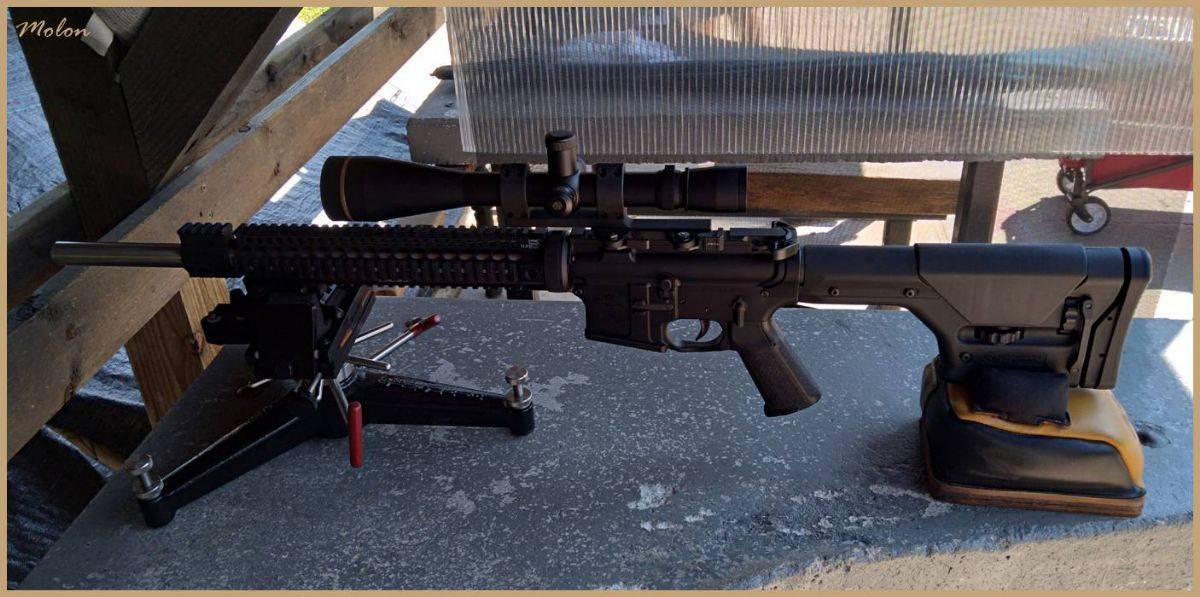
The Wind Probe.

The test vehicle for this evaluation was one of my semi-automatic precision AR-15s with a 20” stainless-steel Lothar Walther barrel. The barrel has a 223 Wylde chamber with a 1:8” twist. Prior to firing the Barnes 5.56mm 85 grain OTM ammunition, I fired a 10-shot control group using match-grade hand-loads topped with the Sierra 77 grain Tipped MatchKing. That group had an extreme spread of 0.68”.


Next, three 10-shot groups of the Barnes Precision Match 5.56mm 85 grain OTM were fired in a row with the resulting extreme spreads:
0.81”
0.76”
0.87”
for a 10-shot group average extreme spread of 0.81”. The three 10-shot groups were over-layed on each other using RSI Shooting Lab to form a 30-shot composite group. The mean radius for the 30-shot composite group was 0.22”.
The smallest 10-shot group . . .

The 30-shot composite group . . .

….

While most well known as a manufacturer of monolithic copper bullets, Barnes is now producing match-grade lead-core, copper-jacketed bullets and loading their own ammunition with these bullets to boot. The focus of this article is one of the loads from the Barnes Precision Match line-up that utilizes one of their lead-core copper-jacketed bullets. As the name for this line of ammunition implies, Barnes stated that the “main focus for this product is accuracy.”
As the title of this article states, the ammunition reviewed for this article is a 5.56mm load (not a 223 Remington load) and there is a warning on the box label stating this ammunition is “NOT FOR USE” in 223 Remington chambers.
This load uses the same 85 grain OTM bullet that Barnes sells as the 85 grain “Match Burner” reloading component, with one exception; the projectile in the loaded ammunition has a cannelure. Barnes stated that they manufacture the bullet for the loaded ammunition with a cannelure “because it will most likely be fired from an AR style platform.” Naturally, I’ll be evaluating the accuracy/precision of this loaded ammunition using an AR-15. The 85 grain Match Burner has an advertised ballistic coefficient of .410.


The 85 grain Match Burner bullet is one of the longest projectiles that is currently being commercially loaded to magazine length in 5.56mm ammunition. The bullet has a nominal length of 1.069” and Barnes recommends that this bullet be used with a barrel that has a 1:8” twist rate, or faster. This Barnes Precision Match ammunition has a loaded cartridge nominal OAL of 2.245”.

The Barnes Precision Match ammunition is charged with a temperature stable ball powder. The round is assembled in a brass case with a headstamp that reads “BBR 5.56 13”. The “BBR” on the headstamp stands for “Barnes Ballistics Research.” Barnes stated that they “source the brass from a European manufacturer.” The primer pocket is sealed and has three “stab” crimps. There is a slight taper crimp at the case-mouth, but no case-mouth sealant.

The individual squares in the red grid shown below are 1/10th of an inch.

I chronographed the Barnes Precision Match 5.56mm 85 grain OTM ammunition from a semi-automatic AR-15 with a chrome-lined, NATO chambered 20” Colt M16A2 barrel with a 1:7” twist.

Chronographing was conducted using an Oehler 35-P chronograph with “proof screen” technology. The Oehler 35P chronograph is actually two chronographs in one package that takes two separate chronograph readings for each shot and then has its onboard computer analyze the data to determine if there is any statistically significant difference between the two readings. If there is a statistically significant difference in the readings, the chronograph “flags” the shot to let you know that the data is invalid. There was no invalid data flagged during this testing.
The velocity stated below is the muzzle velocity as calculated from the instrumental velocity using Oehler’s Ballistic Explorer software program. The string of fire consisted of 10 rounds over the chronograph.

Each round was single-loaded and cycled into the chamber from a magazine fitted with a single-load follower. The bolt locked-back after each shot allowing the chamber to cool in between each shot. This technique was used to mitigate the possible influence of “chamber-soak” on velocity data. Each new shot was fired in a consistent manner after hitting the bolt release. Atmospheric conditions were monitored and recorded using a Kestrel 4000 Pocket Weather Tracker.

Atmospheric conditions
Temperature: 73 degrees F
Humidity: 44%
Barometric pressure: 29.64 inches of Hg
Elevation: 950 feet above sea level
The muzzle velocity for the 10-shot string of the Barnes Precision Match 5.56mm 85 grain OTM ammunition fired from the 20” Colt barrel was 2583 FPS with a standard deviation of 10 FPS and a coefficient of variation of 0.39%.
For those of you who might not be familiar with the coefficient of variation (CV), it is the standard deviation, divided by the mean (average) muzzle velocity and then multiplied by 100 and expressed as a percentage. It allows for the comparison of the uniformity of velocity between loads in different velocity spectrums; e.g. 77 grain loads running around 2,650 fps compared to 55 grain loads running around 3,250 fps.
For comparison, the mil-spec for M193 allows for a coefficient of variation of approximately 1.2%, while one of my best 77 grain OTM hand-loads, with a muzzle velocity of 2639 PFS and a standard deviation of 4 FPS, has a coefficient of variation of 0.15%.

…..
I conducted an accuracy (technically, precision) evaluation of the Barnes Precision Match 5.56mm 85 grain OTM ammunition following my usual protocol. This accuracy evaluation used statistically significant shot-group sizes and every single shot in a fired group was included in the measurements. There was absolutely no use of any group-reduction techniques (e.g. fliers, target movement, Butterfly Shots).
The shooting set-up will be described in detail below. As many of the significant variables as was practicable were controlled for. Also, a control group was fired from the test-rifle used in the evaluation using match-grade, hand-loaded ammunition; in order to demonstrate the capability of the barrel. Pictures of shot-groups are posted for documentation.
All shooting was conducted from a concrete bench-rest from a distance of 100 yards (confirmed with a laser rangefinder.) The barrel used in the evaluation was free-floated. The free-float handguards of the rifle rested in a Sinclair Windage Benchrest, while the stock of the rifle rested in a Protektor bunny-ear rear bag. Sighting was accomplished via a Leupold VARI-X III set at 25X magnification and adjusted to be parallax-free at 100 yards. A mirage shield was attached to the objective-bell of the scope. Wind conditions on the shooting range were continuously monitored using a Wind Probe. The set-up was very similar to that pictured below.

The Wind Probe.

The test vehicle for this evaluation was one of my semi-automatic precision AR-15s with a 20” stainless-steel Lothar Walther barrel. The barrel has a 223 Wylde chamber with a 1:8” twist. Prior to firing the Barnes 5.56mm 85 grain OTM ammunition, I fired a 10-shot control group using match-grade hand-loads topped with the Sierra 77 grain Tipped MatchKing. That group had an extreme spread of 0.68”.


Next, three 10-shot groups of the Barnes Precision Match 5.56mm 85 grain OTM were fired in a row with the resulting extreme spreads:
0.81”
0.76”
0.87”
for a 10-shot group average extreme spread of 0.81”. The three 10-shot groups were over-layed on each other using RSI Shooting Lab to form a 30-shot composite group. The mean radius for the 30-shot composite group was 0.22”.
The smallest 10-shot group . . .

The 30-shot composite group . . .

….
Your trying a bunch of different bullets / loads is prudent.
Even try some boutique 77gr loads ( Creedmoor Sports / Atlanta Arms.. even PSA / AAC 77gr is "decent" if available )
Consider some IMI, It is fairly inexpensive, and if you know what to expect from it then in your barrel, you can get more practice in.
And I don't know your "knowledge" level when it comes to ammo ( no offense intended at all )
But all ammo can have quite a bit of difference velocity wise. So just be aware... IE of the 22 different different 77gr loads I've chrono'd there was a difference of about 400FPS between those factory loads , those were .223 loads and 5.56.
When is your class ?
And just my 2 cents, but I thought SOLGW barrels are made by Aero / BA ... and yours might be great.
But I would consider a better barrel brand if needed, IE your barrel isn't meeting your expectations.... Hence the question about when is your class.
And before I forget, make sure your reticle is plumb on the rifle. It doesn't take much cant to throw off calculations for down range.
Please keep us up to date !
Even try some boutique 77gr loads ( Creedmoor Sports / Atlanta Arms.. even PSA / AAC 77gr is "decent" if available )
Consider some IMI, It is fairly inexpensive, and if you know what to expect from it then in your barrel, you can get more practice in.
And I don't know your "knowledge" level when it comes to ammo ( no offense intended at all )
But all ammo can have quite a bit of difference velocity wise. So just be aware... IE of the 22 different different 77gr loads I've chrono'd there was a difference of about 400FPS between those factory loads , those were .223 loads and 5.56.
When is your class ?
And just my 2 cents, but I thought SOLGW barrels are made by Aero / BA ... and yours might be great.
But I would consider a better barrel brand if needed, IE your barrel isn't meeting your expectations.... Hence the question about when is your class.
And before I forget, make sure your reticle is plumb on the rifle. It doesn't take much cant to throw off calculations for down range.
Please keep us up to date !
Similar threads
- Replies
- 19
- Views
- 2K
